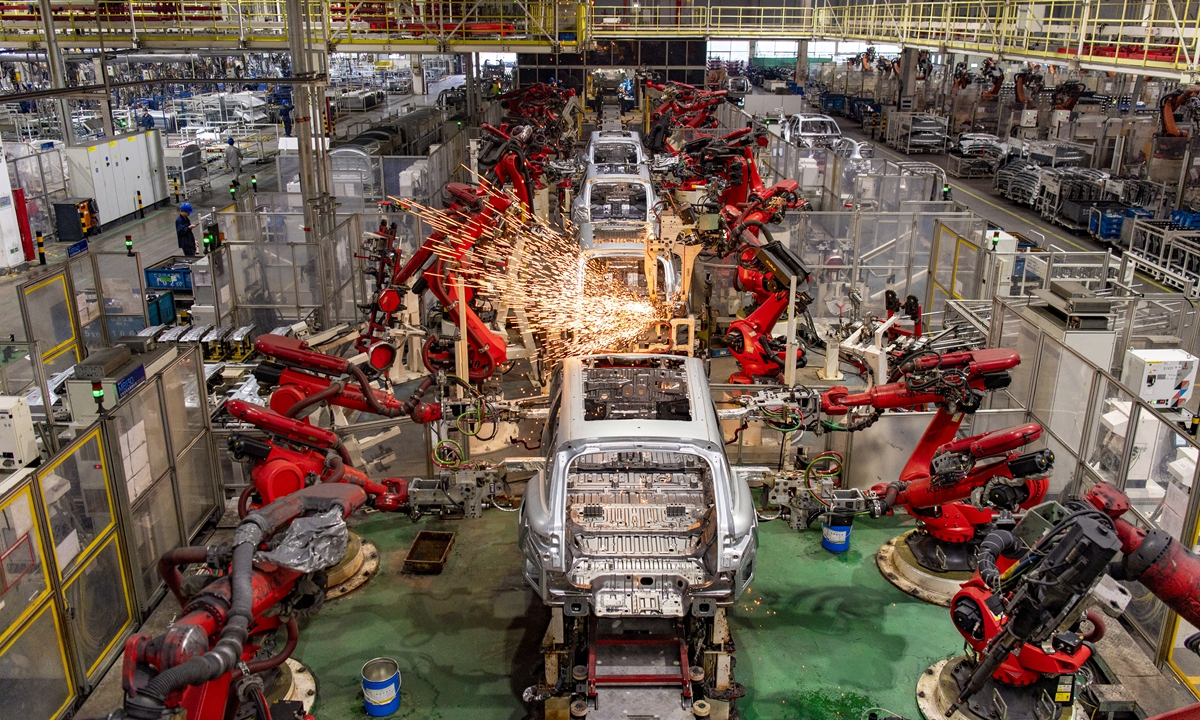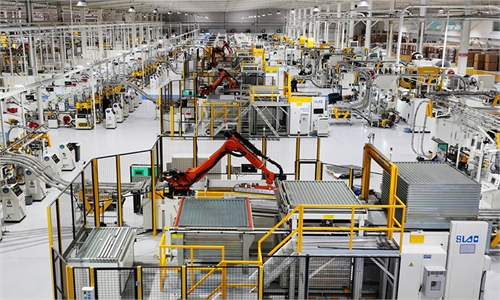Industrial sector leads growth in Q1, with high-tech manufacturing being a highlight
High-tech manufacturing particularly influential, drives quality and quantity of industrial output

Industrial robots weld the frame of NEVs inside an automotive assembly in Jinhua, East China's Zhejiang Province on April 8, 2024. Photo: VCG
China's industrial output significantly boosted the economy in the first quarter of 2024, with value-added industrial output up 6.1 percent year-on-year, according to data released Tuesday by the National Bureau of Statistics (NBS).
The surge in industrial output helped push China's GDP growth to 5.3 percent in the first quarter, surpassing expectations. The sector contributed 37.3 percent of the GDP growth, driving nearly two percentage points of the overall GDP increase.
The industrial sector showed particular strength in China's economic recovery, with overall industrial added value increasing by 6 percent in the first quarter, up 3.1 percentage points from a year earlier, and an improvement of 0.8 percentage points from the fourth quarter in 2023, showing a rebounding and improving trend, Sheng Laiyun, deputy director of the NBS, told a press conference on Tuesday.
Experts noted that market demand improvements, macroeconomic policy support and better inventory and operational conditions in industrial firms all played critical roles. The high-tech manufacturing sub-sector was particularly influential, driving forward both the quality and quantity of industrial output.
As enterprises boosted their inventory and expanded production in response to rising market demand, the operating rate among industrial firms increased. High-tech and equipment manufacturing companies experienced robust expansion, Zhou Maohua, a macroeconomist at China Everbright Bank, told the Global Times on Tuesday.
China is gradually entering a proactive inventory replenishment cycle, with steady industrial output expansion. This is supported by domestic equipment upgrades and global market demand, which are expected to steadily enhance both the scale and quality of industrial development, Zhou noted.
Among major industrial categories, output of the manufacturing sector grew by 6.7 percent, with emerging technology manufacturing emerging as a highlight. According to the NBS, production of charging poles grew by 41.7 percent, production of 3D printing equipment saw 40.6 percent growth, and electronic component production increased by 39.5 percent.
With the development of new quality productive forces, China has seen rapid growth in high-tech manufacturing and the industrial sector, and emerging industries are expected to bring growth to the economy while optimizing the existing manufacturing industry, Cao Heping, an economist at Peking University, told the Global Times on Tuesday.
High-tech manufacturing emerged as a significant bright spot in the overall growth, increasing by 7.5 percent, or by 2.6 percentage points faster than in the fourth quarter of 2023, NBS data showed.
The rapid growth of China's industrial sector is attributed to the development of new quality productive forces and comprehensive industrial chains.
Industrial output is expected to maintain steady expansion with continuous structural optimization. "The resurgence in domestic industrial demand, especially in high-tech manufacturing, along with improved inventory and profitability levels, are likely to sustainably boost industrial sector confidence," Zhou explained.
Growth has been supported by strengthening business confidence, a revival in both domestic and international demand, and proactive government policies aimed at revitalizing industrial growth, Sheng of NBS noted.
Enterprises of different ownerships also showed fast growth in the sector, with state-owned enterprises seeing a 5.2 percent increase in added value and 5.4 percent growth in the added value of private firms.
Economic indicators in March suggest a further recovery, with the Manufacturing Purchasing Managers' index reaching 50.8, up 1.7 points from February. Sub-indexes, such as production and business expectations, stood at 55.6, up 1.4 points from the previous month.
With these supportive factors, China's industrial growth momentum is expected to continue, Sheng stated, emphasizing the ongoing need for substantial support to the economy to secure the recovery.
China has published a series of policies to support the development of its manufacturing and industrial sectors, including a detailed plan to promote the large-scale renewal of equipment and trade-ins of consumer goods.
The plan, issued on March 13 by the State Council, China's cabinet, , aims to revitalize the country's equipment and consumer goods sectors through extensive renewal strategies, driving annual demand exceeding 5 trillion yuan ($690 billion) for equipment in key sectors.
On Tuesday, the National Financial Regulatory Administration issued a document to optimize financial services for the manufacturing industry, aiding the advancement of new industrialization.
The document emphasizes financial support for the manufacturing sector, supporting the security and stability of industrial and supply chains, technological innovation, structural optimization and upgrading, as well as the development of industrial intelligence and green practices.
In general, the economy exceeded expectations in the first quarter of 2024, with GDP growing 5.3 percent, signaling a strong start to the year, the NBS reported on Tuesday. This robust performance is crucial as the country targets full-year growth of about 5 percent.



